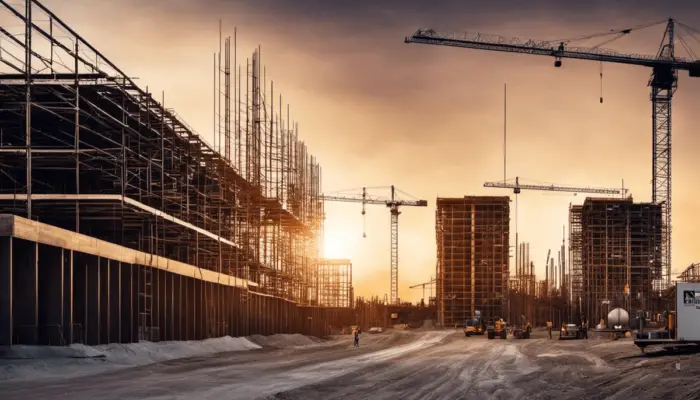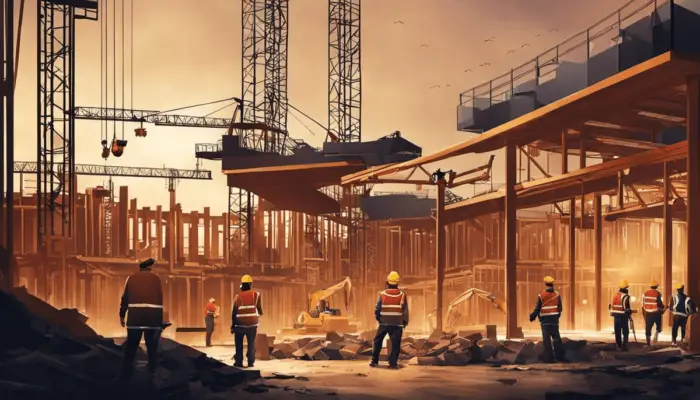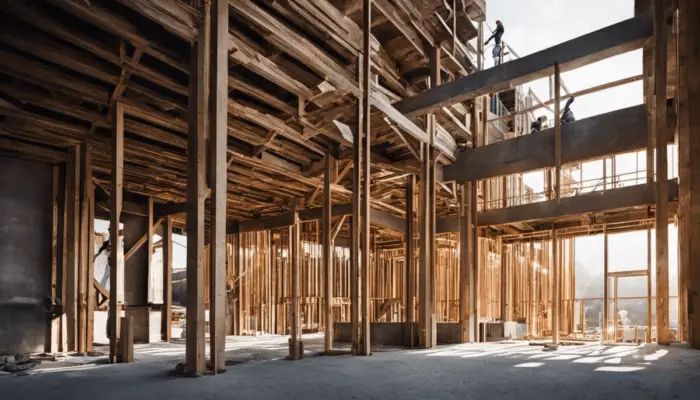In the complex construction world, builder’s risk insurance is a critical safeguard designed to protect investments in myriad ways. This insurance coverage caters to many risks associated with new constructions, renovations, and materials in transit or on-site.
With the potential to shield against the financial consequences of unexpected calamities such as fire, theft, vandalism, and weather-related damages, an intricate understanding of builder’s risk insurance is essential for industry professionals.
This delve into the fundamentals, detailed insurance coverage, exclusions, limitations, and claim process aims to foster a comprehensive understanding of builder’s risk insurance.
Fundamentals of Builder’s Risk Insurance
What is Builder’s Risk Insurance?
Builder’s risk insurance, also known as Course of Construction insurance, is a specialized type of property insurance.
It provides coverage for buildings under construction, renovation, or repair. The policyholder is usually the contractor or developer but can also be the property owner.
Purpose of Builder’s Risk Insurance
The main purpose behind a builder’s risk insurance is to protect the insured party’s investment in a construction project. The construction industry is fraught with risks and unexpected occurrences that can lead to significant financial losses.
These include theft, vandalism, and damage from fires, storms, or accidents. This insurance policy is designed to cover such risks.
Types of Risks Covered by Builder’s Risk Insurance
Builder’s risk insurance typically covers damages to the building itself, the materials and equipment used in construction, and the fixtures or features being adjoined to the structure.
However, this insurance doesn’t usually cover injuries or accidents on the construction site, which fall under liability insurance.
The specific risks covered by this insurance depend on the policy but often include:
- Fire and explosion.
- Theft and vandalism (though only when the property is secured).
- Weather events such as lightning, hail, and wind.
- Accidental events such as a water pipe bursting or a wall falling.
Expectations from Builder’s Risk Insurance
Typically, Builder’s risk insurance does not cover every risk associated with a construction project. Certain risks, such as normal wear and tear, faulty design, and damages due to earthquakes or floods, are often excluded unless additional coverage is purchased.
Therefore, it’s essential to understand what your policy does fully and doesn’t cover.
Policy Term Length, Terms, and Conditions
The term of a builder’s risk insurance policy is usually the length of the construction project. It begins on the policy effective date and ends when the construction is completed and the property is ready for use or occupancy.
Builder’s risk policies are typically written on an “all-risk” basis, meaning they cover all risks except those specifically excluded by the policy. The policyholder is expected to mitigate risks as much as possible. For example, the site should have basic security measures to prevent theft and vandalism.
In conclusion, Builder’s risk insurance is a crucial tool for effectively managing the risks associated with construction projects.
It’s always recommended to speak with a knowledgeable insurance agent or broker specialising in this type of coverage to understand the best options for your specific construction project.

Detailed Insurance Coverage
Understanding Builder’s Risk Insurance Coverage
Builder’s Risk Insurance, also known as Course of Construction Insurance, is a type of property insurance that protects a person’s or organization’s insurable interest in materials, fixtures, and equipment being used in the construction or renovation of a building or structure, should those items sustain physical loss or damage from a covered cause.
Coverage for New Construction Buildings
Under builder’s risk insurance, new construction buildings are covered beginning at the commencement of the construction project.
This encompasses the structure itself and the materials used in its construction. The insurance pays to repair or replace the damaged structure or materials if a covered loss occurs during construction, such as a fire or windstorm.
Coverage for Renovations
In addition to new construction, builder’s risk insurance also covers renovations. When a building undergoes renovation, a significant risk could result in financial loss.
The renovation work and the existing structure are both included in the policy. If a covered loss occurs during the renovation process, insurance proceeds can be used to rebuild or repair the renovation work and, if necessary, the existing structure.
Coverage for Materials in Transit and Onsite
Builder’s risk insurance goes beyond covering the construction or renovation site alone. It also provides coverage for materials in transit and onsite. These are materials destined for the insured construction project.
The policy covers the replacement cost if these materials are damaged or lost while in transit or onsite.
Incidents Covered Under Builder’s Risk Insurance
Builder’s risk insurance typically covers fire, theft, or vandalism losses. It can also protect against certain weather-related damages like hail and lightning.
Depending on the specifics of the policy, it could also offer protection against damages resulting from events like explosions or the crashing of an aircraft or vehicle.
However, it should be noted that most builders’ risk policies exclude coverage for losses due to events such as earthquakes, flooding, or wind in coastal areas unless added by an endorsement. Certain losses, such as those due to acts of war, governmental action, or employee theft, are also typically excluded.
Each builder’s risk insurance policy can be tailored to the specifics of the construction project, and it’s essential to understand what it covers and doesn’t.
Discourse with an experienced insurance agent or broker can help ensure you obtain suitable coverage for your construction or renovation project.

Exclusions and Limitations
Understanding Builder’s Risk Insurance Exclusions and Limitations
Builder’s Risk Insurance, also known as Course of Construction Insurance, is designed to protect building projects under construction, renovation, or repair. However, it’s essential to understand the exclusions and limitations of a typical Builder’s Risk Insurance policy.
Exclusions in Builder’s Risk Insurance Policies
Here are common exclusions that may occur in your Builder’s Risk policy:
- Normal Wear and Tear: Any costs associated with the regular maintenance and aging of the construction project are typically not covered. This includes things like paint chipping, cracking, or fading.
- Employee Theft: If an employee of the insured steals materials, tools, or equipment used in the construction project, the policy doesn’t usually cover the loss.
- Mechanical Breakdown: If equipment or machinery breaks down during construction, this will not be covered unless the damage is due to a covered peril such as a fire or a severe storm.
- Design Flaws: The policy does not include faulty design, workmanship, material, or any losses that arise from these defects. The exception is if such faults result in a covered loss, such as a building collapse.
- Acts of War or Terrorism: Most policies exclude damage from civil war, rebellion, revolution, insurrection or civil strife, terrorism or any warlike action that involves the use or operation of nuclear, radiation or radioactive material.
- Government Action: This includes confiscation or any destruction of property by order of a government or public authority.
- Other exclusions may include consequential losses, pollution, water damage, weather conditions to property in the open, and criminal acts of the insured.
Limitations in Builder’s Risk Insurance Policies
Moreover, builder’s insurance policies have some inherent limitations you should be aware of:
- Length of Coverage: Typically, the coverage is limited to the length of the construction project, and the policy terminates once the project is completed.
- Geographic Limitations: Some policies have limitations based on the project’s physical location; for instance, earthquake coverage may not be included if the project is located in an earthquake-prone region.
- Monetary Limits: A policy usually sets a maximum limit to the amount it will pay for a loss. It’s essential to ensure the limit accurately reflects the total completed value of the project.
- Sub-limits: Certain perils, such as floods or earthquakes, may have their own separate sub-limits apart from overall policy limits.
You must carefully review your policy’s terms, conditions, exclusions, and limitations. In cases of uncertainty, it’s advisable to consult with a trusted insurance professional to clarify any gray areas and ensure a full understanding of your coverage.

Claiming the Insurance
The Documentation Process for Builder’s Risk Insurance
When filing for a builder’s risk insurance claim, the first task is to gather all necessary documents. These include the original insurance policy, occurrence documentation such as incident reports or photographs, and any bills or invoices related to repairs or replacements.
Any communications between contractors, construction management, and the insurance company should also be organized and kept for reference.
Builder’s Risk Insurance Claim Notice
Immediately after a loss, you must notify the insurance company. This can typically be done over the phone or through an online system. The company will then send you claim forms and instructions. Fill out these forms carefully, accurately stating all your losses.
Assessment of Damage for Builder’s Risk Insurance Claim
Your insurance company will assign a claims adjuster to your case. The adjuster’s job is to assess the damage and determine the insurance company’s liability.
This involves a physical survey of the damaged property, where they will verify the extent of the loss claimed. The adjuster will also review all the documents and may ask for additional information if necessary.
Handling Partial Losses With Builder’s Risk Insurance
In partial losses, the insurance company will calculate the cost required to restore the property to its state before the incident.
This could involve assessing repair costs of damaged equipment or reconstructing certain project sections. The policyholder then receives a settlement check, which equals the repair or replacement cost less any deductible mentioned in the policy.
Managing Total Losses With Builder’s Risk Insurance
In the event of a total loss, where the entire property is lost to a covered peril, the insurance company determines the policy’s limits and pays out the full limit, less the deductible, if any. Importantly, the insurance company will not pay for costs more than the policy’s limit.
Calculating The Value of Your Claim
Calculating a builder’s risk insurance claim value can be influenced by a few factors, like the type of loss suffered and the type of valuation mentioned in your policy – either actual cash value, replacement cost, or extended replacement cost.
Actual cash value considers depreciation, while replacement cost coverage does not. An extended replacement cost may cover expenses above policy limits if replacement costs have increased over time.
Understanding these terms and how your claim will be valued better is crucial to estimate the expected reimbursement value from such a claim.
Always be forthright and timely when communicating with your insurance provider when making a claim. Delays and misinformation can hinder the claim’s process and potentially lead to coverage denial.

Conclusion
Moving from an introductory understanding to an in-depth exploration of builder’s risk insurance helps uncover the intricacies and nuances of the policy.
A comprehensive knowledge of what’s covered, what’s not, and how to effectively claim insurance in the event of an incident is truly empowering. With an understanding of policy term length, exclusions, and the methodology for calculating a claim’s value, industry professionals can make informed decisions about builder’s risk insurance.
In a field that is vulnerable to many risks, having a detailed understanding of these insurances acts as a defensive tool, enabling preparedness and strategic planning, ultimately contributing to project and investment protection.

Chris Ekai is a Risk Management expert with over 10 years of experience in the field. He has a Master’s(MSc) degree in Risk Management from University of Portsmouth and is a CPA and Finance professional. He currently works as a Content Manager at Risk Publishing, writing about Enterprise Risk Management, Business Continuity Management and Project Management.
